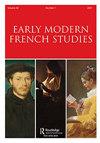‘Sçavoir bien badiner est un grand avantage’: Monkey Business in the Labyrinth of Versailles
IF 0.2
3区 历史学
Q2 HISTORY
引用次数: 2
Abstract
The Labyrinth of Versailles was a splendid horticultural space in early modern France frequented by courtiers and very likely by Louis XIV’s son the dauphin. In this article, the author argues that the Labyrinth stood as a vital locus of etiquette formation for the court, and more widely, the surrounding Parisian villages and early modern Europe at large. Fouquet’s usurpation of kingly authority comes into play, as well as political allegory, that tie together to show the crucial nature of the Labyrinth as an architectural space that ultimately influences comportment of the era. The author examines texts by Charles Perrault, Isaac de Benserade, and engravings by Sébastien Le Clerc. She considers two of the most important fountains within the verdant passageways, those of the monkey king and the monkey judge, which showcase the critical nature of imitation for acceptable comportment of the period.“玩得开心是一个很大的优势”:凡尔赛迷宫中的猴子生意
凡尔赛迷宫是近代早期法国的一个辉煌的园艺空间,朝臣们经常光顾,很可能是路易十四的儿子太子。在这篇文章中,作者认为迷宫是宫廷礼仪形成的重要场所,更广泛地说,是周围巴黎村庄和早期现代欧洲的重要场所。Fouquet对王权的篡夺,以及政治寓言,这些联系在一起,显示了迷宫作为一个最终影响时代行为的建筑空间的关键性质。作者考察了查尔斯·佩罗、艾萨克·德·本塞拉德的文本和ssamubastien Le Clerc的版画。她考虑了翠绿通道中最重要的两个喷泉,即孙悟空和猴子法官的喷泉,它们展示了模仿对当时可接受的行为的关键性质。
本文章由计算机程序翻译,如有差异,请以英文原文为准。
求助全文
约1分钟内获得全文
求助全文
来源期刊

Early Modern French Studies
Multiple-
CiteScore
0.10
自引率
0.00%
发文量
14
期刊介绍:
Early Modern French Studies (formerly Seventeenth-Century French Studies) publishes high-quality, peer-reviewed, original articles in English and French on a broad range of literary, cultural, methodological, and theoretical topics relating to the study of early modern France. The journal has expanded its historical scope and now covers work on the sixteenth, seventeenth, and eighteenth centuries. Within this period of French literary and cultural history, the journal particularly welcomes work that relates to the term ''early modern'', as well as work that interrogates it. It continues to publish special issues devoted to particular topics (such as the highly successful 2014 special issue on the cultural history of fans) as well as individual submissions.
 求助内容:
求助内容: 应助结果提醒方式:
应助结果提醒方式:


